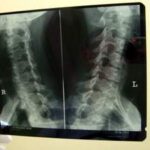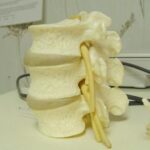I have cervical spinal stenosis, and I had surgery to open the way for the nerves that were severely compressed almost seven years ago. Before seeking relief with the help of pain medication and muscle relaxers, I suffered from frequent pain and muscle spasms across my shoulders and around the area of the cervical spinal stenosis surgery. I suffered for almost six years before going to a doctor for pain medication, but that pain medication has proved to be the cause of even more pain – until I realized what was causing the excruciating headaches that leave me completely debilitated, nauseated, and suffering even more than the original pain caused by the cervical spinal stenosis.
If you have cervical spinal stenosis and take prescription pain medications and muscle relaxers, and if you are experiencing debilitating headaches, consider the following information. Before I realized what was causing my headaches and bouts of nausea and vomiting, I suffered terribly about once every three weeks. With the help of my family I finally figured out what was causing the painful headaches. Since discovering the source, I’ve adjusted my medication regimen, and I no longer suffer with headaches. Consider your pain medication and how you take it to manage the pain and muscle spasms of cervical spinal stenosis. Cervical spinal stenosis is a painful condition, but it doesn’t have to be made worse with medications that are suppose to help stop the pain.
Precautionary Statement
Not all instances of pain are caused by the medications that are meant to alleviate it. If you have cervical spinal stenosis and are suffering from headaches or other painful episodes, contact a spine specialist for advice. The following information is a personal experience, and although it’s meant to help others suffering from pain and headaches caused by cervical spinal stenosis and the medications used in treatment, it isn’t meant to replace professional medical advice or care.
Soma (Carisoprodol) and Ultram (Tramadol)
I was prescribed generic forms of Soma (Carisoprodol), and Ultram (Tramadol), to treat the pain and muscle spasms of cervical spinal stenosis, and the directions said to take the medications 4 times a day. I didn’t want to take the pain medication or muscle relaxers any more than necessary, and I began taking them once a day in the evening when the pain was the worst. Before long I needed it twice a day, and I took my first dose around 2:00 p.m., and the last dose at 6:00 p.m. This worked well for a while, but I was experiencing problems earlier in the day, and eventually I began taking both medications three times a day. This was perfectly acceptable since I was directed to take them four times a day, but I didn’t want to be under the influence of an addictive muscle relaxer all day long.
Dosage Problems?
About once a week I felt the need to take the fourth dose of medication to alleviate the pain caused by cervical spinal stenosis, and in most cases I didn’t suffer ill effects, but I began suffering from headaches that were excruciating and caused vomiting. My head and neck hurt intensely, and I couldn’t bare to watch television or work on the computer. Sleeping didn’t even take away the pain. All I could do was moan and groan and practically pull my hair out while waiting for relief.
I began wondering what could be causing my terrible headaches. I had surgery for cervical spinal stenosis more than six years ago, and I only began experiencing these symptoms after going on the prescription medications. Even the cervical spinal stenosis wasn’t as painful as these headaches. Each time I had terrible headaches it was after taking a forth dose of Carisoprodol and Tramadol. I’d take it late at night about an hour before going to bed, and the next day I’d wake up feeling terrible. As the day wore on I’d feel worse and worse until I’d eventually vomit. After vomiting I’d begin to feel a little better, and in most cases I wouldn’t feel completely better until waking up the following morning.
Finding Relief
I’ve since cut out the fourth dose of Carisoprodol and Tramadol, and although it’s only been a couple of weeks since completely eliminating the fourth dose, I haven’t had any more debilitating headaches. It didn’t make sense at first since there were times I didn’t take a fourth dose and didn’t end up with a headache, but then I realized a particular pattern. I ended up with a headache if I took the fourth dose and went to bed before it was completely out of my system. I don’t think my body processed the medication as it should have, and my body tried to rid itself of the toxins.
The conclusion I’ve reached may or may not be correct, but if you’re suffering from headaches after going on Carisoprodol and/or Tramadol to treat the pain of cervical spinal stenosis, consider how and when you take the medication. It could very well be the cause of your headaches. Contact your doctor or pharmacist for more information about these drugs, and seek professional advice before changing your dosage.




